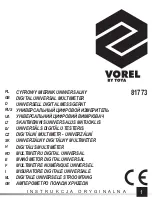
Multimeters
Safe
Working
Practices
3
• Use only correct measurement category (CAT), voltage, and amperage rated
probes, test leads, and adapters for the measurement.
• Measure a known voltage first to make sure that the Product operates
correctly.
• Do not use test leads if they are damaged. Examine the test leads for
damaged insulation and measure a known voltage.
• Limit operation to the specified measurement category, voltage, or amperage
ratings.
• Do not apply more than the rated voltage, between the terminals or between
each terminal and earth ground.
• Do not use the HOLD function to measure unknown potentials. When HOLD
is turned on, the display does not change when a different potential is
measured.
• Do not touch voltages >30 V ac rms, 42 V ac peak, or 60 V dc.
• Do not use test leads if they are damaged. Examine the test leads for
damaged insulation and measure a known voltage.
106 & 107
Users Manual
4
• Keep fingers behind the finger guards on the probes.
• Remove all probes, test leads, and accessories before the battery door is
opened.
• Do not exceed the Measurement Category (CAT) rating of the lowest rated
individual component of a Product, probe, or accessory.
• Remove the input signals before you clean the Product.
• Use only specified replacement parts.
• Use only specified replacement fuses.
• Have an approved technician repair the Product.
• Remove the batteries if the Product is not used for an extended period of
time, or if stored in temperatures above 50 °C. If the batteries are not
removed, battery leakage can damage the Product.
• Replace the batteries when the low battery indicator shows to prevent
incorrect measurements.
For safe operation and maintenance of the product, repair the Product before
use if the batteries leak.


































